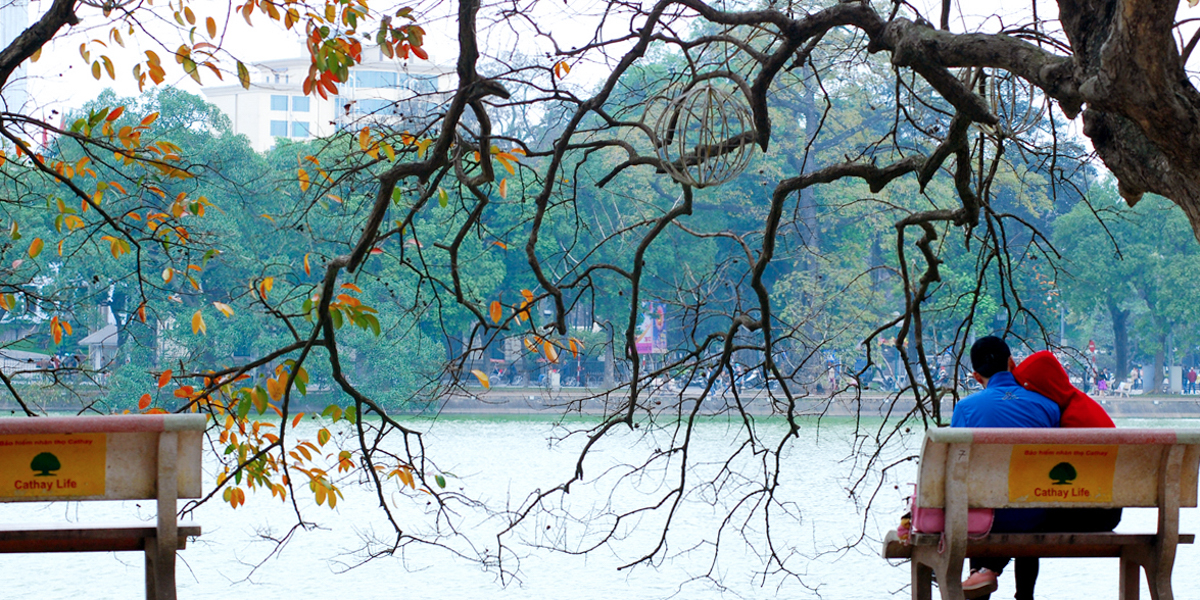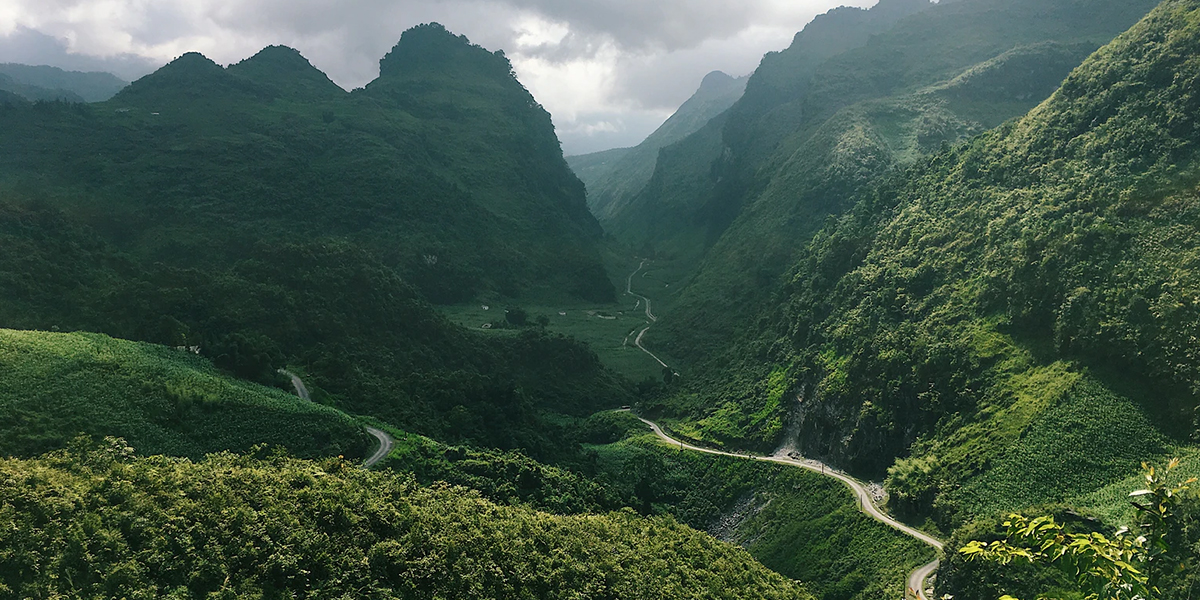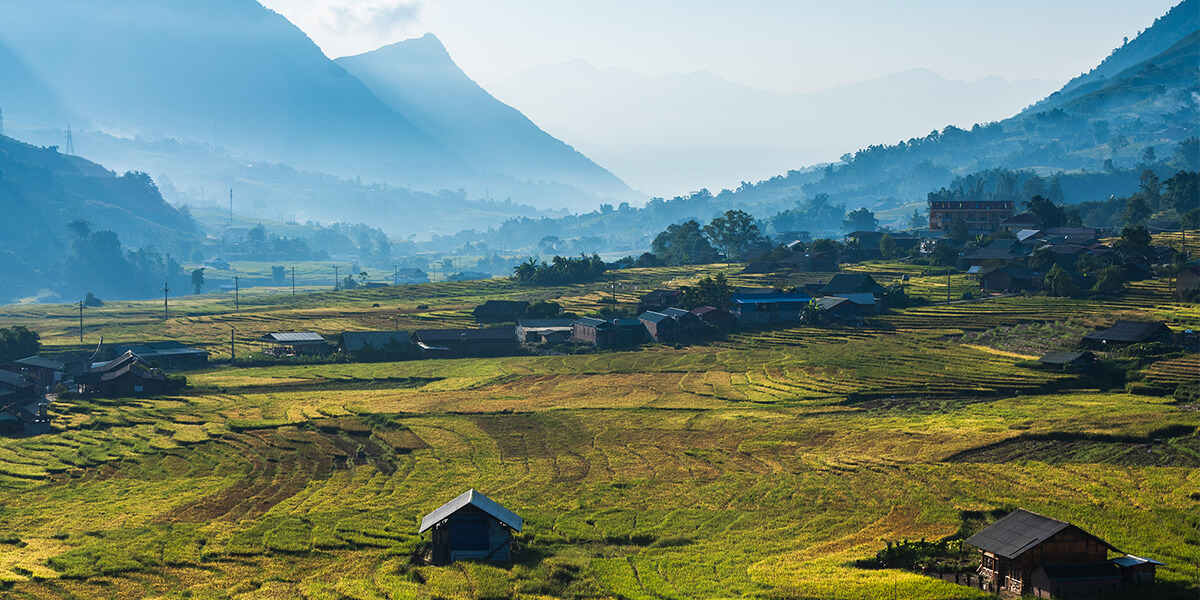Having an S-shape stretching from 23°23 'North to 8°27' North (quite close to the equator), Vietnam's territory is entirely located in the tropics. Therefore, the climate of Vietnam also has a distinct division into three main climate types: Subtropical humid, Monsoon and Tropical savanna. The weather in Vietnam has a diverse range because of the separation and interference of two types of humid tropical and subtropical climates. This also leads to the diversity of vegetation - plants and marine life here.
I - Vietnam weather conditions in a year

Source: Kiril Dobrev
1 - Temperature in Vietnam
The annual average temperature from North to South in Vietnam is about 21 - 27°C, in which the temperature tends to increase gradually from the North to the South (due to the geographical location in the South closer to the equator). The lowest temperature in Vietnam can reach below 0°C in winter at some high altitudes in the North such as Ha Giang Province, Fansipan Peak in Sapa Town, Phia Oac Mountain in Cao Bang Province,... Meanwhile, summer time from May to August witnesses the hottest months with the highest temperature that can rise up to 39 - 40°C or even more.
The weather in Vietnam is also affected by the greenhouse effect and global warming. The annual average temperature in Vietnam in particular and in other countries in the world increases each year. Especially the melting ice phenomenon in the Arctic makes the sea level constantly rise.
2 - Rainfall in Vietnam
The average annual rainfall measured at hydro-meteorological stations in Vietnam is from 1.500 to 2.000mm. However, due to the differentiation between Vietnam weather and the typical East Coast terrain, the country often experiences extreme weather phenomena such as storms, floods, heavy rain, hail, peak heat, cyclones... On average, the whole territory of Vietnam annually experiences from 11 to 13 big and small storms each year.
3 - Humidity in Vietnam
The average humidity in Vietnam is usually around 80%. However, in the northern monsoon tropics, the humidity in the air changes seasonally. Specifically as follows:
- Spring: high humidity 94%
- Summer and autumn: average humidity 80%
- Winter: low humidity about 50%
Vietnam weather throughout the year: The weather chart below includes average temperature & rainfall during 12 months of the year in Vietnam.
|
Month |
Temp (oC) |
Rainfall (mm) |
|
1 |
21.33 |
29.89 |
|
2 |
21.73 |
18.73 |
|
3 |
23.94 |
33.14 |
|
4 |
26.01 |
81.68 |
|
5 |
27.38 |
182.04 |
|
6 |
27.75 |
226.58 |
|
7 |
27.63 |
269.06 |
|
8 |
27.28 |
305.81 |
|
9 |
26.74 |
298.90 |
|
10 |
25.28 |
299.88 |
|
11 |
27.42 |
143.50 |
|
12 |
22.03 |
66.14 |
II - Vietnam weather & some typical phenomena
1 - Thunder and lightning in Vietnam
Thunder and lightning are frequent phenomena associated with thunderstorms and heavy storms. This is what happens when clouds with opposing charges discharge each other. Vietnam is considered as "one of the three great thunderstorms centers of the world", so that the phenomenon of thunder and lightning also takes place quite often in Vietnam.
2 - Snow and the coldest weather in Vietnam

Snow in Sapa - Source: Metrip
Over the past 10 years, Vietnamese people have had the opportunity to witness the snow falling. However, this phenomenon only occurs in the northern mountainous areas in Vietnam where the temperature drops deeply, sometimes reaching -4.4oC usually in the middle of winter from December 15 to January 10 of the annual calendar. Some places in Vietnam in which snow can be appeared such as: Fansipan Peak in Sapa Town, Mau Son Peak in Lang Son Province, Ta Xua Peak in Yen Bai Province, Ba Vi National Park in Hanoi (rarely), Moc Chau District in Son La Province, Van Cung Peak in Bac Giang Province (rarely), Yen Tu Peak in Quang Ninh Province, Tam Dao District in Vinh Phuc Province (rarely),... Snow in frozen & foggy weather is an extremely interesting experience in a tropical country like Vietnam.
3 - Extreme weather phenomena
Vietnam is considered as one of the countries in the world affected most by climate change. In recent years, the frequency and intensity of extreme weather phenomena occurring in this country is dramatically increasing. Some of the harsh conditions that you can come across in Vietnam are namely:
Tropical storm and tropical depression
Every year, Vietnam is hit with dozens of storms forming in the Pacific Ocean which causes heavy damage in both human and property. They often happen from July to November and the North and the Central of Vietnam are the most typhoon-prone areas.
Flood
Floods have impacted all regions of Vietnam. In Central Vietnam, flooding is mainly caused by typhoons while in the South and North Vietnam, flooding results from long and heavy rain in the summer and dry season. In Northern mountainous areas, soil soaked in water after many days will result in sudden landslides which can bury a whole village in the blink of an eye.
Drought
Contrary to storms and floods, drought often happens in the dry season in Central Vietnam. This is the time that the temperature can reach over 40°C and the lack of rain lasts for months, influencing agriculture and daily activities.
III - What is the weather like in Vietnam by region?
Vietnam is a long narrow country in the S-shape with three main regions: North, Central, and South. The terrain has a complex differentiation, with many types of terrain from high mountains to plains and long coastal areas. The climate of Vietnam is dominated by many different factors, so the climatic characteristics of each region in Vietnam also have certain differences. This creates a rather profound regional climate character in Vietnam. The North has 4 distinct seasons (spring, summer, fall and winter), the South is characterized by two seasons: dry season and rainy season. Meanwhile, Central has the most complicated weather conditions area due to the difference of typography.
1 - Vietnam weather in the Northern region
With a humid tropical climate, divided into 4 seasons: Spring, Summer, Autumn and Winter, the North is the cradle that produces a variety of fruits associated with each season. The most recognizable feature of the northern climate is hot summer with a lot of rain, and cold winter with little rain. The annual average air temperature is 23.6°C, the hottest month is June (29.8°C), the coldest is January (17.2°C). The average annual humidity in the North is 79% and the rainfall is 1800mm.
Spring in Northern Vietnam
In the Spring in the North, it reminds people of cold winds and the time when it is drizzling in the sky or days when the Vietnam weather is warm, irrespective of morning, noon, evening. There is one thing that cannot be forgotten, spring is also the season of festivals, traveling around the country. Spring coats the North by the change in color of plants and flowers. Hundreds of flowers bloom, each flower has a unique scent that adorns the northern spring more brilliantly, bringing visitors' feet to enjoy the colors of the festival.
Summer in Northern Vietnam
This is the season of warm sunshine, humidity and rain. Coming to the North in summer, you can not forget the harsh sun that you want to dry all. The harsh sun protection accessories such as hats, sun protection shirts, masks, and sunglasses are always by your side when you want to go out. However, summer is also the busiest season of the year. The shops, and entertainment centers are always overloaded. The beaches, the sun and wind, the cool blue water will give you a feeling of an interesting summer in Vietnam.
- Northeastern and Northwestern region: a region with hilly terrain, summer here is not too hot, but winter is quite cold, while in summer there are often floods in the mountains.
- Hanoi and the Red River Delta: there is not much sunlight here, only about 1450 hours/year. In July and August, the humidity is highest, so the temperature increases higher. May and June have the highest temperature up to 39°C. The most pleasant time is October and November when the monsoon ends.
Autumn in Northern Vietnam
This is the season that brings the North the most romantic beauty of the year. Visitors to the North in autumn will not forget the characteristics of the weather here: cool and dry. The street is filled with images of yellow leaves fluttering in the wind as suggesting the lyrics for a certain collection of poems. And perhaps, autumn in the North will also be a season for you to remember the time you arrive at the famous tourist attractions of this country.
Winter in Northern Vietnam
This is the season of cold in high mountains, sometimes snow falls, low humidity and dryness due to the influence of the northeast monsoon. But this is also the season of love and reunification. If you come to the North this season, you will be impressed with the coldness of the early winter winds, the milky white space of the morning dew and the tranquility of the lake surface. All for you to feel the rare tangible beauty of the Vietnam weather in winter in the North.
2 - Weather in Vietnam’s central region
The weather in Central Vietnam has a sharp division according to topography.
North Central (Thanh Hoa Province to Thua Thien-Hue Province)
The weather in this region is quite similar to that of the North Vietnam which is divided into 4 seperate seasons. Spring and autumn here swiftly pass while summer lasts long and the temperature is high due to the influence of westerly wind. Because of direct northeasterly wind, in the winter, it is quite cold and dry here (the average temperature in January can decrease to 18°C).
South Central (Danang City to Binh Thuan Province)
The monsoon tropical climate divides this area into the rainy and dry seasons clearly. The rainy season starts in May and ends in October when there are a lot of rains and even storms, the average rainfall in these months can reach 1,600-2000mm. In contrast, the dry season (November to April) is characterized by hot weather, continuous wind blows and prolonged drought in which the rainfall is, on average, below 200mm while the average temperature is higher, from 24 - 28°C.
The Central Highland (including the provinces of Kon Tum, Gia Lai, Dak Lak, Dak Nong and Lam Dong)
With an altitude of 500-600m above sea level, there are also two seasons in the Central Highland of Vietnam: dry season & rainy season. The rainy season takes place from May to October, and the dry season from November to April next year. The dry season is hot, drought, lack of water seriously, the rainy season is hot and humid, concentrating about 85-90% of the annual rainfall. The highland land is full of wind, rich and diversified products of the Central Highlands.
3 - Vietnam weather in the South

Rain in Saigon - Source: Internet
Located in the tropical monsoon and sub-equatorial climate, the average temperature in months of the year in Southern region is over 18oC, with abundant sunlight. The temperature of day and night between months of the year is low and very mild. Average humidity ranges from 80-82%. The South of Vietnam has 2 main seasons: rainy season and dry season. The dry season starts in November and ends in May, the rainy season starts from May and ends at the end of November.
Traveling to South Vietnam, you will be impressed with the sudden rains that usually appear in the afternoon but only last a short time. A lovely umbrella or a convenient raincoat would be indispensable in your backpack.
Summer in the South also gives you a more comfortable feeling than Northern summer. It is sunny but not hot as the wind blowing in from the sea brings steam to balance the heat. You can freely choose clothes when traveling without worrying about the weather changing.
IV - More information of Vietnam weather
1 - Diseases caused by weather in Vietnam
Due to monsoon and rainy - sunny weather, there are some typical diseases caused by weather changes such as flu, pneumonia, red eye pain, allergies, osteoarthritis pain, heart failure, sinusitis, etc. Especially for the northern area in the spring when the humidity is high, the temperature is not too low, this is a favorable condition for viruses, bacteria and molds to grow and reproduce. Hence, tourists should take care and be well-prepared about health when traveling to Vietnam.
2 - When is the best weather in Vietnam?
Depending on the tourist destination and the experience activities, you can choose the right time to come to Vietnam such as:
- In the Northern region, if you want to watch the snow fall, you should come around December - January. Swimming activities and outdoor experiences should choose the period from April to August.
- The Central region's weather & climate is a bit more complicated than the other areas due to the diversified topography. The Northern Central region has a similar climate to the Northern region while the Southern central weather is more likely to the Southern region. In general, the best time to come here is from late November to July when the whole region is in the dry season.
- In the Southern region, avoid the rainy season of October and November every year.
To have a more comfortable traveling time, tourists should have a detailed plan and remember to check the weather conditions in Vietnam weather forecasts apps like Accuweather.
Thus, it can be seen that the weather in Vietnam has a diversified differentiation in each region stretching along latitudes from North to South. Along with that characteristic, Vietnam weather is also a condition to help develop tourism and other exploration of the country. In particular, the subtropical and tropical climate is very suitable for developing sea and island tourism.







.jpg) — Ha Bich
— Ha Bich

















